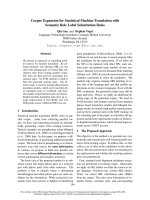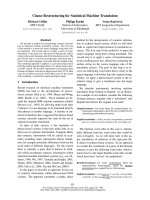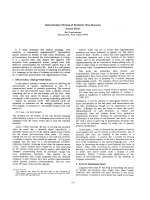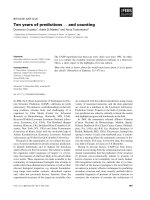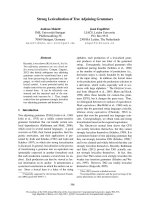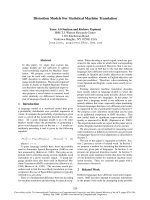Báo cáo khoa học: "Computational Complexity of Statistical Machine Translation" doc
Bạn đang xem bản rút gọn của tài liệu. Xem và tải ngay bản đầy đủ của tài liệu tại đây (132.7 KB, 8 trang )
Computational Complexity of Statistical Machine Translation
Raghavendra Udupa U.
IBM India Research Lab
New Delhi
India
Hemanta K. Maji
Dept. o f Computer Science
University of Illinois at Urbana-Champaigne
Abstract
In this paper w e study a set of prob-
lems that are of considerable importance
to Statistical Machine Translation (SMT)
but which have not been addressed satis-
factorily by the SMT research community.
Over the last decade, a variety of SM T
algorithms have been built and empiri-
cally tested whereas little is known about
the computational complexity of some of
the fundamental problems of SMT. Our
work aims at providing useful insights into
the the computational complexity of those
problems. We prove that while IBM Mod-
els 1-2 are conceptually and computation-
ally simple, computations involving the
higher (and more useful) models are hard.
Since it is unlikely that there exists a poly-
nomial time solution for any of these hard
problems (unless P = NP and P
#P
=
P), our results highlight and justify the
need for developing polynomial time ap-
proximations for these computations. We
also discuss some practical ways of deal-
ing with complexity.
1 Introduction
Statistical Machine Translation is a data driven
machine translation technique which uses proba-
bilistic models of natural language for automatic
translation (Brown et al., 1993), (Al-Onaizan et
al., 1999). The parameters of the models are
estimated by iterative m aximum-likelihood train-
ing on a large parallel corpus of natural language
texts using the EM algorithm (Brown et al., 1993).
The models are then used to decode, i.e. trans-
late texts from the source language to the target
language
1
(Tillman, 2001), (Wang, 1997), (Ger-
mann et al., 2003), (Udupa et al., 2004). The
models are independent of the language pair and
therefore, can be used to build a translation sys-
tem for any language pair as long as a parallel
corpus of texts is available for training. Increas-
ingly, parallel corpora are becoming available
for many language pairs and SMT systems have
been built for French-English, German-English,
Arabic-English, Chinese-English, Hindi-English
and other language pairs (Brown et al., 1993), (A l-
Onaizan et al., 1999), (Udupa, 2004).
In SMT, every English sentence e is considered
as a translation of a given French sentence f with
probability P r (f |e). Therefore, the problem of
translating f can be viewed as a problem of finding
the most probable translation of f :
e
∗
= argmax
e
P r(e|f ) = argmax
e
P r(f |e)P (e).
(1)
The probability distributions P r(f |e) and
P r(e) are known as translation model and lan-
guage model respectively. In the classic work on
SMT, Brown and his colleagues at IBM introduced
the notion of alignment between a sentence f and
its translation e and used it in the development of
translation models (Brown et al., 1993). An align-
ment between f = f
1
. . . f
m
and e = e
1
. . . e
l
is a many-to-one mapping a : {1, . . . , m} →
{0, . . . , l}. Thus, an alignment a between f and e
associates the french word f
j
to the English word
e
a
j
2
. The number of words of f mapped to e
i
by
a is called the fertility of e
i
and is denoted by φ
i
.
Since P r (f |e) =
a
P r(f , a|e), equation 1 can
1
In this paper, we use French and English as the prototyp-
ical examples of source and target languages respectively.
2
e
0
is a special word called the null word and is used to
account for those words in f that are not connected by a to
any of the words of e.
25
be rewritten as follows:
e
∗
= argmax
e
a
P r(f , a|e)P r(e). (2)
Brown and his colleagues developed a series
of 5 translation models which have become to be
known in the field of machine translation as IBM
models. For a detailed introduction to IBM trans-
lation models, please see (Brown et al., 1993). In
practice, models 3-5 are known to give good re-
sults and models 1-2 are used to seed the E M it-
erations of the higher models. IBM model 3 is
the prototypical translation model and it models
P r(f , a|e) as follows:
P (f , a|e) ≡ n
φ
0
|
l
i=1
φ
i
l
i=1
n (φ
i
|e
i
) φ
i
!
×
m
j=1
t
f
j
|e
a
j
×
j: a
j
=0
d (j|i, m, l)
Table 1: IBM Model 3
Here, n(φ|e) is the fertility model, t(f|e) is
the lexicon model and d(j|i, m, l ) is the distortion
model.
The computational tasks involving IBM Models
are the following:
• Viterbi Alignment
Given the model parameters and a sentence
pair (f , e), determine the most probable
alignment between f and e.
a
∗
= argmax
a
P (f , a|e)
• Expectation Evaluation
This forms the core of model training via the
EM algorithm. Please see Section 2.3 for
a description of the computational task in-
volved in the EM iterations.
• Conditional Probability
Given the model parameters and a sentence
pair (f , e), compute P (f |e).
P (f |e) =
a
P (f , a|e)
• Exact Decoding
Given the model parameters and a sentence f ,
determine the most probable translation of f .
e
∗
= argmax
e
a
P (f , a|e) P (e)
• Relaxed Decoding
Given the model parameters and a sentence f ,
determine the most probable translation and
alignment pair for f .
(e
∗
, a
∗
) = argmax
(e,a)
P (f , a|e) P (e)
Viterbi Alignment computation finds applica-
tions not only in SMT but also in other areas
of Natural Language Processing (Wang, 1998),
(Marcu, 2002). Expectation Evaluation is the
soul of parameter estimation (Brown et al., 1993),
(Al-Onaizan et al., 1999). Conditional Proba-
bility computation is important in experimentally
studying the concentration of the probability mass
around the Viterbi alignment, i.e. in determining
the goodness of the Viterbi alignment in compar-
ison to the rest of the alignments. Decoding is
an integral component of all SMT systems (Wang,
1997), (Tillman, 2000), (Och et al., 2001), (Ger-
mann et al., 2003), (Udupa et al., 2004). Exact
Decoding is the original decoding problem as de-
fined in (Brown et al., 1993) and Relaxed Decod-
ing is the relaxation of the decoding problem typ-
ically used in practice.
While several heuristics have been developed
by practitioners of SMT for the computational
tasks involving IBM models, not much is known
about the computational complexity of these tasks.
In their seminal paper on SMT, Brown and his col-
leagues highlighted the problems we face as we go
from IBM Models 1-2 to 3-5(Brown et al., 1993)
3
:
“As we progress from Model 1 to Model 5, eval-
uating the expectations that gives us counts be-
comes increasingly difficult. In Models 3 and 4,
we must be content with approximate EM itera-
tions because it is not feasible to carry out sums
over all possible alignments for these models. In
practice, we are never sure that we have found the
Viterbi alignment”.
However, neither their work nor the subsequent
research in SMT studied the computational com-
plexity of these fundamental problems with the
exception of the Decoding problem. In (Knight,
1999) it was proved that the Exact Decoding prob-
lem is NP-Hard when the language model is a bi-
gram model.
Our results may be summarized as follows:
3
The emphasis is ours.
26
1. Viterbi Alignment computation is NP-Hard
for IBM Models 3, 4, and 5.
2. Expectation Evaluation in EM Iterations is
#P-Complete for IBM Models 3, 4, and 5.
3. Conditional Probability computation is
#P-Complete for IBM Models 3, 4, and 5.
4. Exact Decoding is #P-Hard for IBM Mod-
els 3, 4, and 5.
5. Relaxed Decoding is NP-Hard for IBM
Models 3, 4, and 5.
Note that our results for decoding are sharper
than that of (Knight, 1999). Firstly, we show that
Exact Decoding is #P-Hard for IBM Models 3-5
and not just NP-Hard. Secondly, we show that
Relaxed Decoding is NP-Hard for Models 3-5
even when the language model is a uniform dis-
tribution.
The rest of the paper is organized as follows.
We formally define all the problems discussed in
the paper (Section 2). Next, we take up each of the
problems discussed in this section and derive the
stated result for them (Section 3). After this, w e
discuss the implications of our results (Section 4)
and suggest future directions (Section 5).
2 Problem Definition
Consider the functions f, g : Σ
∗
→ {0, 1}. We
say that g ≤
m
p
f (g is polynomial-time many-one
reducible to f ), if there exists a polynomial time
reduction r(.) such that g(x) = f (r(x)) for all
input instances x ∈ Σ
∗
. This means that given a
machine to evaluate f (.) in polynomial time, there
exists a machine that can evaluate g(.) in polyno-
mial time. We say a function f is NP-Hard, if all
functions in NP are polynomial-time many-one
reducible to f . In addition, if f ∈ NP, then we
say that f is NP-Complete.
Also relevant to our work are counting func-
tions that answer queries such as “how many com-
putation paths exist for accepting a particular in-
stance of input?” Let w be a witness for the ac-
ceptance of an input instance x and χ (x, w) be
a polynomial time witness checking function (i.e.
χ(x, w) ∈ P). The function f : Σ
∗
→ N such that
f (x) =
w∈Σ
∗
|w|≤p(|x|)
χ(x, w)
lies in the class #P, where p(.) is a polynomial.
Given functions f, g : Σ
∗
→ N, we say that g is
polynomial-time Turing reducible to f (i.e. g ≤
T
f ) if there is a Turing machine with an oracle for
f that computes g in time polynomial in the size
of the input. Similarly, we say that f is #P-Hard,
if every function in #P can be polynomial time
Turing reduced to f . If f is #P-Hard and is in
#P, then we say that f is #P-Complete.
2.1 Viterbi Alignment Computation
VITERBI-3 is defined as follows. Given the para-
meters of IBM Model 3 and a sentence pair (f , e),
compute the most probable alignment a
∗
betwen f
and e:
a
∗
= argmax
a
P (f , a|e).
2.2 Conditional Probability Computation
PROBABILITY-3 is defined as follows. Given
the parameters of IBM Model 3, and a sen-
tence pair (f , e), compute the probability
P (f |e) =
a
P (f , a|e).
2.3 Expectation Evaluation in EM Iterations
(f, e)-COUNT-3, (φ, e)-COUNT-3, (j, i, m , l)-
COUNT-3, 0-COUNT-3, and 1-COUNT-3 are de-
fined respectively as follows. Given the parame-
ters of IBM Model 3, and a sentence pair (f , e),
compute the following
4
:
c(f|e; f , e) =
a
P (a|f , e)
j
δ(f, f
j
)δ(e, e
a
j
),
c(φ|e; f , e) =
a
P (a|f , e)
i
δ(φ, φ
i
)δ(e, e
i
),
c(j|i, m, l; f , e) =
a
P (a|f , e)δ(i, a
j
),
c(0; f , e) =
a
P (a|f , e)(m − 2φ
0
), and
c(1; f , e) =
a
P (a|f , e)φ
0
.
2.4 Decoding
E-DECODING-3 and R-DECODING-3 are defined
as follows. Given the parameters of IBM Model 3,
4
As the counts are normalized in the EM iteration, we can
replace P (a|f , e) by P (f , a|e) in the Expectation Evaluation
tasks.
27
and a sentence f , compute its most probable trans-
lation according to the following equations respec-
tively.
e
∗
= argmax
e
a
P (f , a|e) P (e)
(e
∗
, a
∗
) = argmax
(e,a)
P (f , a|e) P (e).
2.5 SETCOVER
Given a collection of sets C = {S
1
, . . . , S
l
} and
a set X ⊆ ∪
l
i=1
S
i
, find the minimum cardinality
subset C
of C such that every element in X be-
longs to at least one member of C
.
SETCOVER is a well-known NP-Complete
problem. If SETCOVER ≤
m
p
f , then f is NP-
Hard.
2.6 PERMANENT
Given a matrix M = [M
j,i
]
n×n
whose entries are
either 0 or 1, compute the following:
perm(M) =
π
n
j=1
M
j,π
j
where π is a per-
mutation of 1, . . . , n.
This problem is the same as that of counting the
number of perfect matchings in a bipartite graph
and is known to be #P-Complete (?). If PERMA-
NENT ≤
T
f , then f is #P-Hard.
2.7 COMPAREPERMANENTS
Given two matrices A = [A
j,i
]
n×n
and B =
[B
j,i
]
n×n
whose entries are either 0 or 1, determine
which of them has a larger permanent. PERMA-
NENT is known to be Turing reducible to COM-
PAREPERMANENTS (Jerrum, 2005) and therefore,
if COMPAREPERMANENTS ≤
T
f , then f is #P-
Hard.
3 Main Results
In this section, we present the main reductions
for the problems with Model 3 as the translation
model. Our reductions can be easily carried over
to Models 4−5 with minor modifications. In order
to keep the presentation of the main ideas simple,
we let the lexicon, distortion, and fertility models
to be any non-negative functions and not just prob-
ability distributions in our reductions.
3.1 VITERBI-3
We show that VITERBI- 3 is NP-Hard.
Lemma 1 SETCOVER ≤
m
p
VITERBI-3.
Proof: We give a polynomial time many-one
reduction from SETCOVER to VITERBI-3. Given
a collection of sets C = {S
1
, . . . , S
l
} and a set
X ⊆ ∪
l
i=1
S
i
, we create an instance of VITERBI-3
as follows:
For each set S
i
∈ C, we create a word e
i
(1 ≤ i ≤
l). Similarly, for each element v
j
∈ X we create
a word f
j
(1 ≤ j ≤ |X| = m). We set the model
parameters as follows:
t (f
j
|e
i
) =
1 if v
j
∈ S
i
0 otherwise
n (φ|e) =
1
2φ!
if φ = 0
1 if φ = 0
d (j|i, m, l) = 1.
Now consider the sentences e =
e
1
. . . e
l
and f = f
1
. . . f
m
.
P (f , a|e) = n
φ
0
|
l
i=1
φ
i
l
i=1
n (φ
i
|e
i
) φ
i
!
×
m
j=1
t
f
j
|e
a
j
j: a
j
=0
d (j|i, m, l)
=
l
i=1
1
2
1−δ(φ
i
,0)
We can construct a cover for X from the output
of V ITERBI-3 by defining C
= {S
i
|φ
i
> 0}. We
note that P (f , a|e) =
n
i=1
1
2
1−δ
(
φ
i
,0
)
= 2
−|C
|
.
Therefore, Viterbi alignment results in the mini-
mum cover for X.
3.2 PROBABILITY-3
We show that PROBABILITY-3 is #P-Complete.
We begin by proving the following:
Lemma 2 PERMANENT ≤
T
PROBABILITY-3.
Proof: Given a 0, 1-matrix M =
[M
j, i
]
n×n
, we define f = f
1
. . . f
n
and e =
e
1
. . . e
n
where each e
i
and f
j
is distinct and set
the Model 3 parameters as follows:
t (f
j
|e
i
) =
1 if M
j,i
= 1
0 otherwise
n (φ|e) =
1 if φ = 1
0 otherwise
d (j|i, n, n) = 1.
28
Clearly, with the above parameter setting,
P (f , a|e) =
n
j=1
M
j, a
j
if a is a permutation
and 0 otherwise. Therefore,
P (f |e) =
a
P (f , a|e)
=
a is a permutation
n
j=1
M
j, a
j
= perm (M)
Thus, by construction, PROBABILITY-3 com-
putes perm (M). Besides, the construction con-
serves the number of witnesses. Hence, PERMA-
NENT ≤
T
PROBABILITY-3.
We now prove that
Lemma 3 PROBABILITY-3 is in #P.
Proof: Let (f , e) be the input to
PROBABILITY-3. Let m and l be the lengths
of f and e respectively. With each alignment
a = (a
1
, a
2
, . . . , a
m
) we associate a unique num-
ber n
a
= a
1
a
2
. . . a
m
in base l + 1. Clearly,
0 ≤ n
a
≤ (l + 1)
m
− 1. Let w be the binary
encoding of n
a
. Conversely, with every binary
string w we can associate an alignment a if the
value of w is in the range 0, . . . , (l + 1)
m
− 1. It
requires O (m log (l + 1)) bits to encode an align-
ment. Thus, given an alignment we can compute
its encoding and given the encoding we can com-
pute the corresponding alignment in time polyno-
mial in l and m. Similarly, given an encoding we
can compute P (f , a|e) in time polynomial in l and
m. Now, if p(.) is a polynomial, then function
f (f , e) =
w∈{0,1}
∗
|w|≤p(|f , e|)
P (f , a|e)
is in #P. Choose p (x) = x log
2
(x + 1).
Clearly, all alignments can be encoded using at
most p (| (f , e) |) bits. Therefore, if (f , e) com-
putes P (f |e) and hence, PROBABILITY-3 is in
#P.
It follows immediately from L emma 2 and
Lemma 3 that
Theorem 1 PROBABILITY-3 is #P-Complete.
3.3 (f, e)-COUNT-3
Lemma 4 PERMANENT ≤
T
(f, e)-COUNT-3.
Proof: The proof is similar to that of
Lemma 2. Let f = f
1
f
2
. . . f
n
ˆ
f and e =
e
1
e
2
. . . e
n
ˆe. We set the translation model para-
meters as follows:
t (f|e) =
1 if f = f
j
, e = e
i
and M
j,i
= 1
1 if f =
ˆ
f and e = ˆe
0 otherwise.
The rest of the parameters are set as in Lemma 2.
Let A be the set of alignments a, such that a
n+1
=
n + 1 and a
n
1
is a permutation of 1, 2, . . . , n. Now,
c
ˆ
f |ˆe; f , e
=
a
P (f , a|e)
n+1
j=1
δ(
ˆ
f , f
j
)δ(ˆe , e
a
j
)
=
a∈A
P (f , a|e)
n+1
j=1
δ(
ˆ
f , f
j
)δ(ˆe , e
a
j
)
=
a∈A
P (f , a|e)
=
a∈A
n
j=1
M
j, a
j
= perm (M) .
Therefore, PERMANENT ≤
T
COUNT-3.
Lemma 5 (f, e)-COUNT-3 is in #P.
Proof: The proof is essentially the same as
that of Lemma 3. Note that given an encoding w,
P (f , a|e)
m
j=1
δ (f
j
, f ) δ
e
a
j
, e
can be evalu-
ated in time polynomial in |(f , e)|.
Hence, from Lemma 4 and Lemma 5, it follows
that
Theorem 2 (f, e)-COUNT-3 is #P-Complete.
3.4 (j, i, m , l)-COUNT-3
Lemma 6 PERMANENT ≤
T
(j, i, m, l)-COUNT-
3.
Proof: We proceed as in the
proof of Lemma 4 with some modifica-
tions. Let e = e
1
. . . e
i−1
ˆee
i
. . . e
n
and
f = f
1
. . . f
j−1
ˆ
f f
j
. . . f
n
. The parameters
are set as in Lemma 4. Let A be the set of
alignments, a, such that a is a permutation of
1, 2, . . . , (n + 1) and a
j
= i. Observe that
P (f , a|e) is non-zero only for the alignments in
A. It follows immediately that with these para-
meter settings, c(j|i, n, n; f , e) = perm (M) .
Lemma 7 (j, i, m, l)-COUNT-3 is in #P.
Proof: Similar to the proof of Lemma 5.
Theorem 3 (j, i, m, l)-COUNT-3 is #P-
Complete.
29
3.5 (φ, e)-COUNT-3
Lemma 8 PERMANENT ≤
T
(φ, e)-COUNT-3.
Proof: Let e = e
1
. . . e
n
ˆe and f =
f
1
. . . f
n
k
ˆ
f . . .
ˆ
f. Let A be the set of alignments
for which a
n
1
is a permutation of 1, 2, . . . , n and
a
n+k
n+1
=
k
(n + 1) . . . (n + 1). We set
n (φ|e) =
1 if φ = 1 and e = ˆe
1 if φ = k and e = ˆe
0 otherwise.
The rest of the parameters are set as in Lemma 4.
Note that P (f , a|e) is non-zero only for the align-
ments in A. It follows immediately that with these
parameter settings, c(k|ˆe; f , e) = perm (M) .
Lemma 9 (φ, e)-COUNT-3 is in #P.
Proof: Similar to the proof of Lemma 5.
Theorem 4 (φ, e)-COUNT-3 is #P-Complete.
3.6 0-COUNT-3
Lemma 10 PERMANENT ≤
T
0-COUNT-3.
Proof: Let e = e
1
. . . e
n
and f = f
1
. . . f
n
ˆ
f.
Let A be the set of alignments, a, such that a
n
1
is
a permutation of 1, . . . , n and a
n+1
= 0. We set
t (f|e) =
1 if f = f
j
, e = e
i
and M
j, i
= 1
1 if f =
ˆ
f and e = NULL
0 otherwise.
The rest of the parameters are set as in Lemma 4.
It is easy to see that with these settings,
c(0;f ,e)
(n−2)
=
perm (M) .
Lemma 11 0-COUNT-3 is in # P.
Proof: Similar to the proof of Lemma 5.
Theorem 5 0-COUNT-3 is #P-Complete.
3.7 1-COUNT-3
Lemma 12 PERMANENT ≤
T
1-COUNT-3.
Proof: We set the parameters as in
Lemma 10. It follows immediately that
c(1; f , e) = perm (M) .
Lemma 13 1-COUNT-3 is in # P.
Proof: Similar to the proof of Lemma 5.
Theorem 6 1-COUNT-3 is #P-Complete.
3.8 E-DECODING-3
Lemma 14 COMPAREPERMANENTS ≤
T
E-
DECODING-3
Proof: Let M and N be the two 0-1 m atri-
ces. Let f = f
1
f
2
. . . f
n
, e
(1)
= e
(1)
1
e
(1)
2
. . . e
(1)
n
and e
(2)
= e
(2)
1
e
(2)
2
. . . e
(2)
n
. Further, let e
(1)
and
e
(2)
have no words in common and each word
appears exactly once. By setting the bigram lan-
guage model probabilities of the bigrams that oc-
cur in e
(1)
and e
(2)
to 1 and all other bigram prob-
abilities to 0, we can ensure that the only trans-
lations considered by E-DECODING-3 are indeed
e
(1)
and e
(2)
and P
e
(1)
= P
e
(2)
= 1. We
then set
t (f|e) =
1 if f = f
j
, e = e
(1)
i
and M
j,i
= 1
1 if f = f
j
, e = e
(2)
i
and N
j,i
= 1
0 otherwise
n (φ|e) =
1 φ = 1
0 otherwise
d (j|i, n, n) = 1.
Now, P
f |e
(1)
= perm (M), and P
f |e
(2)
=
perm (N ). Therefore, given the output of E-
DECODING-3 we can find out w hich of M and
N has a larger permanent.
Hence E-DECODING-3 is #P − Hard.
3.9 R-DECODING-3
Lemma 15 SETCOVER ≤
m
p
R-DECODING-3
Proof: Given an instance of SETCOVER, we
set the parameters as in the proof of Lemma 1 with
the following modification:
n (φ|e) =
1
2φ!
if φ > 0
0 otherwise.
Let e be the optimal translation obtained by solv-
ing R-DECODING-3. As the language model is
uniform, the exact order of the words in e is not
important. Now, we observe that:
• e contains words only from the set
{e
1
, e
2
, . . . , e
l
}. This is because, there can-
not be any zero fertility word as n (0|e) = 0
and the only words that can have a non-zero
fertility are from {e
1
, e
2
, . . . , e
l
} due to the
way we have set the lexicon parameters.
• No word occurs more than once in e. Assume
on the contrary that the word e
i
occurs k > 1
30
times in e. Replace these k occurrences by
only one occurrence of e
i
and connect all the
words connected to them to this word. This
would increase the score of e by a factor of
2
k−1
> 1 contradicting the assumption on
the optimality of e.
As a result, the only candidates for e are subsets of
{e
1
, e
2
, . . . , e
l
} in any order. It is now straight for-
ward to verify that a minimum set cover can be re-
covered from e as shown in the proof of Lemma 1.
3.10 IBM Models 4 and 5
The reductions are for Model 3 can be easily ex-
tended to Models 4 and 5. Thus, we have the fol-
lowing:
Theorem 7 Viterbi Alignment computation is
NP-Hard for IBM Models 3 − 5.
Theorem 8 Expectation Evaluation in the EM
Steps is #P-Complete for IBM Models 3 − 5.
Theorem 9 Conditional Probability computation
is #P-Complete for IBM M odels 3 − 5.
Theorem 10 Exact Decoding is #P-Hard for
IBM Models 3 − 5.
Theorem 11 Relaxed Decoding is NP-Hard for
IBM Models 3 − 5 even when the language model
is a uniform distribution.
4 Discussion
Our results answer several open questions on the
computation of Viterbi Alignment and Expectation
Evaluation. Unless P = NP and P
#P
= P,
there can be no polynomial time algorithms for
either of these problems. The evaluation of ex-
pectations becomes increasingly difficult as we go
from IBM Models 1-2 to Models 3-5 exactly be-
cause the problem is #P-Complete for the latter
models. There cannot be any trick for IBM Mod-
els 3-5 that would help us carry out the sums over
all possible alignments exactly. There cannot exist
a closed form expression (whose representation is
polynomial in the size of the input) for P (f |e) and
the counts in the EM iterations for Models 3-5.
It should be noted that the computation of
Viterbi Alignment and Expectation Evaluation is
easy for Models 1-2. What makes these computa-
tions hard for Models 3-5? To answer this ques-
tion, we observe that Models 1-2 lack explicit fer-
tility model unlike Models 3-5. In the former mod-
els, fertility probabilities are determined by the
lexicon and alignment models. Whereas, in Mod-
els 3-5, the fertility model is independent of the
lexicon and alignment models. It is precisely this
freedom that makes computations on Models 3-5
harder than the computations on Models 1-2.
There are three different ways of dealing with
the computational barrier posed by our problems.
The first of these is to develop a restricted fertil-
ity model that permits polynomial time computa-
tions. It remains to be found what kind of parame-
terized distributions are suitable for this purpose.
The second approach is to develop provably good
approximation algorithms for these problems as is
done with many NP-Hard and #P-Hard prob-
lems. Provably good approximation algorithms
exist for several covering problems including Set
Cover and Vertex Cover. Viterbi Alignment is itself
a special type of covering problem and it remains
to be seen whether some of the techniques devel-
oped for covering algorithms are useful for finding
good approximations to Viterbi Alignment. Sim-
ilarly, there exist several techniques for approxi-
mating the permanent of a matrix. It needs to be
explored if some of these ideas can be adapted for
Expectation Evaluation.
As the third approach to deal with complex-
ity, we can approximate the space of all possi-
ble (l + 1)
m
alignments by an exponentially large
subspace. To be useful such large subspaces
should also admit optimal polynomial time al-
gorithms for the problems we have discussed in
this paper. This is exactly the approach taken
by (Udupa, 2005) for solving the decoding and
Viterbi alignment problems. They show that very
efficient polynomial time algorithms can be de-
veloped for both Decoding and Viterbi Alignment
problems. Not only the algorithms are prov-
ably superior in a computational complexity sense,
(Udupa, 2005) are also able to get substantial im-
provements in BLEU and NIST scores over the
Greedy decoder.
5 Conclusions
IBM models 3-5 are widely used in SMT. The
computational tasks discussed in this work form
the backbone of all SMT systems that use IBM
models. We believe that our results on the compu-
tational complexity of the tasks in SMT will result
in a better understanding of these tasks from a the-
oretical perspective. We also believe that our re-
sults may help in the design of effective heuristics
31
for some of these tasks. A theoretical analysis of
the commonly employed heuristics will also be of
interest.
An open question in SMT is whether there ex-
ists closed form expressions (whose representation
is polynomial in the size of the input) for P (f |e)
and the counts in the EM iterations for models 3-5
(Brown et al., 1993). For models 1-2, closed form
expressions exist for P (f |e) and the counts in the
EM iterations for models 3-5. Our results show
that there cannot exist a closed form expression
(whose representation is polynomial in the size of
the input) for P (f |e) and the counts in the E M
iterations for Models 3-5 unless P = NP.
References
K. Knight. 1999. Decoding Complexity in Word-
Replacement Translation Mode ls. Computational
Linguistics.
Brown, P. et al: 1993. The Mathematics of Machine
Translation: Parameter Estimation. Computational
Linguistics, 2(19):263–311 .
Al-Onaizan, Y. et al. 1999. Statistical Machine Trans-
lation: Fin a l Report. JHU Workshop Fina l Report.
R. Udupa, and T. Faruquie. 2004. An English-Hindi
Statistical Machine Translation System. Proceed-
ings of the 1st IJCNLP.
Y. Wang, and A. Waibel. 1998. Modeling with Struc-
tures in Statistical Machin e Translation. Proceed-
ings of the 36th ACL.
D. Marcu and W. Wong. 2002. A Phrase-Based, Joint
Probability Mo del for Statistical Machine Transla-
tion. Proceedings of the E MNLP.
L. Valiant. 1979. The complexity of computin g the
permane nt. Theoretical Computer Science, 8:189–
201.
M. Jerrum . 2005. Personal comm unication.
C. Tillman. 2001. Word Re-ordering and Dynamic
Programming based Search Algorithm for Statistical
Machine Translation. Ph.D. Thesis, University of
Technology Aachen 42–45.
Y. Wang and A. Waibel. 2001. Decoding algorithm in
statistical machine translation. Proceedings of the
35th ACL 366–3 72.
C. Tillman and H. Ney. 2000. Word reordering and
DP-based search in statistical machine translation.
Proceedings of the 18th COLING 850–856.
F. Och, N. Ueffing, and H. Ney. 2000. An efficient A*
search a lgorithm for statistical machine translation.
Proceedings of the ACL 200 1 Workshop on Data-
Driven Methods in Machine Translation 55–62.
U. Germann et al. 2003. Fast Decoding and Optimal
Decoding fo r Machine Translation. Artificial Intel-
ligence.
R. Udupa, H. Maji, and T. Faruquie. 2004. An Al-
gorithmic Framework for the Decoding Problem in
Statistical Machine Translation. Proceedings of the
20th COLING.
R. Udupa and H. Maji. 2005. Theory of Alignment
Generators and Applications to Statistical Machine
Translation. Proceedings of the 19th IJCAI.
32

